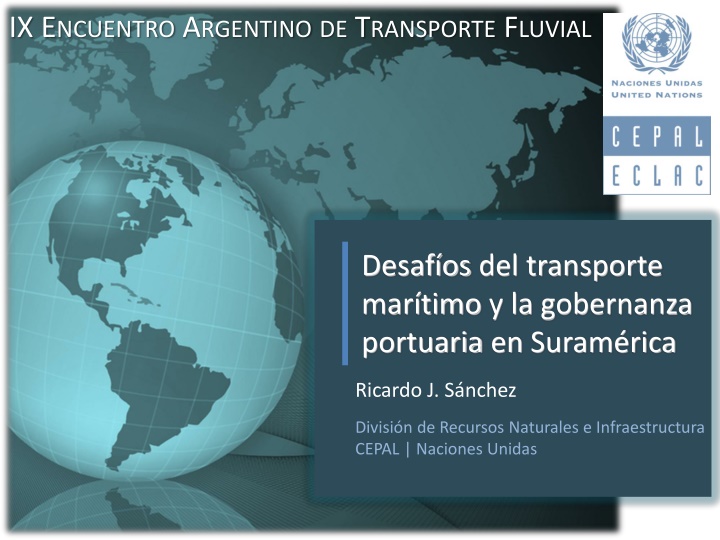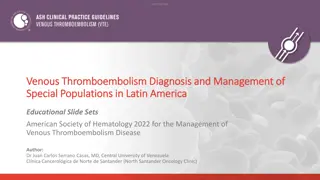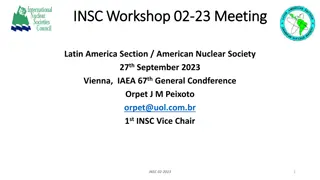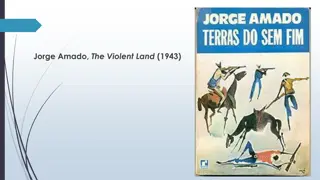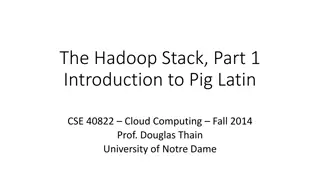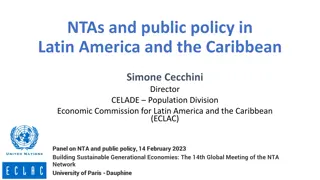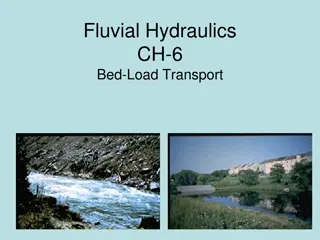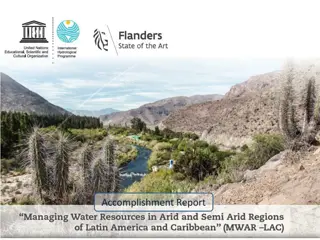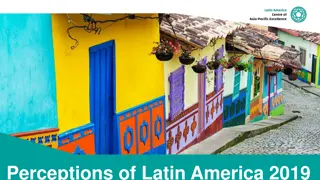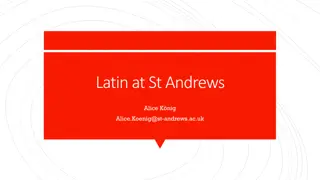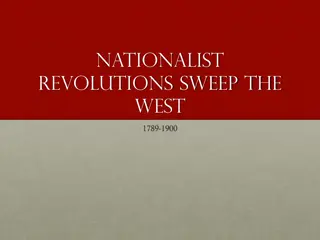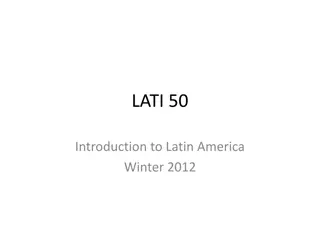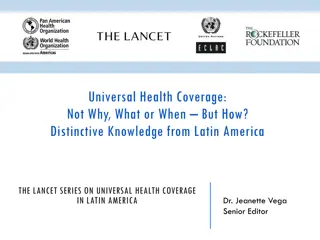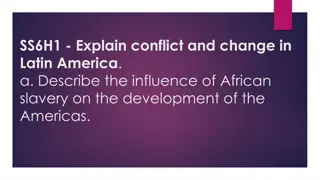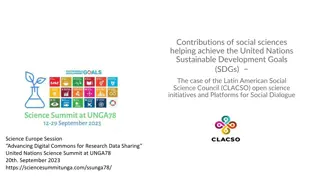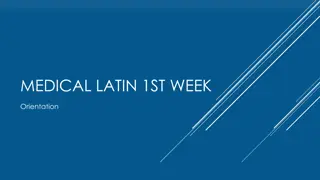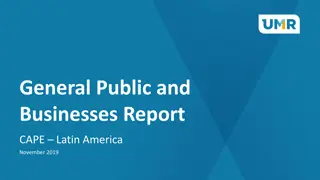Insights on Fluvial Transport Challenges in Latin America
The IX Argentine Encounter on Fluvial Transport highlighted challenges in maritime transport and port governance in South America. Issues include lack of investments, regulatory barriers, and sustainability criteria absence. The infrastructure investment trends and modal distribution have impacted competitiveness and sustainability negatively.
Download Presentation

Please find below an Image/Link to download the presentation.
The content on the website is provided AS IS for your information and personal use only. It may not be sold, licensed, or shared on other websites without obtaining consent from the author.If you encounter any issues during the download, it is possible that the publisher has removed the file from their server.
You are allowed to download the files provided on this website for personal or commercial use, subject to the condition that they are used lawfully. All files are the property of their respective owners.
The content on the website is provided AS IS for your information and personal use only. It may not be sold, licensed, or shared on other websites without obtaining consent from the author.
E N D
Presentation Transcript
IX ENCUENTRO ARGENTINO DE TRANSPORTE FLUVIAL Desaf os del transporte mar timo y la gobernanza portuaria en Suram rica Ricardo J. S nchez Divisi n de Recursos Naturales e Infraestructura CEPAL | Naciones Unidas
LAC: Diagnosis and major infrastructure challenges Physical restraint & shortage => investments and funding High dispersion and multiplicity of views in public & private action Failures and regulatory / institutional barriers Weakness or absence of sustainability criteria 2
Latin America: infrastructure investment by sector, 1980-2012*, (percentage of GDP) 4.5 4.0 3.94 (1987) 3.71 (2009) 3.5 3.5% 3.0 3.0% 2.7% 2.5 2.2% 2.0 1.6% 1.5 1.2% 1.0 1.0% 1.1% 0.5 0.5% 0.0 1980 1982 1984 1986 1988 1990 1992 1994 1996 1998 2000 2002 2004 2006 2008 2010 2012 Inversi n total Inversi n p blica Inversi n privada 3 Source: Unidad de Servicios de Infraestructura de la Divisi n de Recursos Naturales e Infraestructura de CEPAL.
Evolution of supply and demand feeds the transport infrastructure gap (base year 1990=100) Source: Infrastructure Services Unit on their own preliminaries data, from Calder n & Serv n (2010) CEPAL (2011) and ongoing joint studies with CAF and BID & World Trade Monitor. Preliminary estimation. Notes: * Countries are Argentina, Brazil, Chile, Colombia, Mexico y Peru. Since 2003, Bolivia, Costa Rica, Ecuador, El Salvador, Guatemala, Nicaragua, Panam y Paraguay are included as well. ** Data in the last two years are a projection, using the average in the last ten years. 4
LAC: Status of infrastructure (2012) 35,000 200 200 RAIL NETWORK EVOLUTION 2007-2012 (km) 180 180 30,000 TRAFFIC DENSITY 2011-2012 (Total red by 100 km2) 160 160 25,000 140 140 120 120 20,000 100 100 15,000 80 80 60 60 10,000 40 40 5,000 20 20 0 0 0 CRI COL BOL URY BRA HND PER NIC ECU MEX VEN PRY PAN Promedio OECD SLV GTM CHL ARG Alemania DOM Cor e del Sur ARG BOL BRA CHL COL CRI ECU MEX PER URY VEN 2007 2012 2007 2012 Promedio LAC (2012) Average Latin America (2012) 5
Modal distribution and its evolution unfavorable to the competitiveness and sustainability Modal transport distribution in imports &exports in South America (Volume, Thousand tons) 35000.0 29924.8 30000.0 25000.0 20000.0 16964.9 15000.0 10000.0 3982.7 5000.0 1370.5 500.4 135.2 0.0 A reo Air Mar timo Maritime Otro Other Ferroviario Railway Fluvial Waterway Carretera Road 2004 2012 Source: USI/ECLAC, BTI, 2015 Note: Includes Argentina, Brazil, Chile, Colombia, Ecuador, Paraguay, Peru and Uruguay 6
increasing increasing energy costs energy costs infrastructure infrastructure governance governance carbon footprint carbon footprint sustainability of infrastructure logistics and mobility human capital and human capital and resource resource management management efficiency and efficiency and competitiveness competitiveness long term economic long term economic efficiency efficiency investment into energy investment into energy infrastructure infrastructure social costs social costs (accidents, security) (accidents, security) 7
Logistics strategy and planning in Latin America Infrastructure, transport and logistics, are mutually dependent and therefore produce complex issues require holistic analysis and integrated solutions. Globalized and competitive markets, require continued improvements in the quality of the products and price, hence the importance of logistics planning. Logistics strategies and planning in particular, has been absent from public policy. Most countries still develop transport policies focus in one mode and not in terms of the overall competitiveness, efficiency and applying sustainability criteria Very few countries monitor their progress and advances in logistics performance 8
Maritime transport and the crisis: main facts of 2014 Is it the end of the crisis? a challenging macroeconomic environment but some positive lights, bunker prices: a short fresh breath, a chronic overcapacity in the key east-west trade arteries which disturbs the supply-demand equilibrium, the cascading effects of this overcapacity which could, in effect, jeopardise the profitability of other trade lanes, a overhang of orders that is due to be delivered and, may yet, present the biggest threat to all freight rate recovery efforts. better profits for a set of companies (as an industry average) process of mergers, acquisitions and alliances will be strengthened. 9
LAC: Fullcontainerships maximum size 1984-2020 Source: S nchez &Perrotti (2012) 10
Global expected fleet: as June 2016, if Merger HSDG + CCNI is confirmed O3 (CCU) is finally done And a double German occurs (HHCC) ?? Transatl ntico Asia - Mediterraneo Transpac fico 2M G6 2M G6 yy CKYHE G6 CMA-CGM OTROS CKYHE 2M OTROS CMA-CGM OTROS CMA-CGM CKYHE 11
What to think? What to do? Port Governance Logistics & Mobility Governance 12
Port governance: past and future Governance 1.0 Governance 2.0 Old Dev. Landlord New landlord? Tool Goals Goals Instruments Instruments ACOMPLISHMENTS New policies, institution & governance Public policies 13
Governance 1.0 Governance 2.0 Previews governance models Landlord New Landlord? Tool Public ports Extreme modal vision Reducing tax burden of ports Incorporate of private equity Increase of the competition Improve the competitiveness of foreign trade Centralization decentralization Containers Old public ports + new Integrated and systemic vision Rationalization Private and public capital Social efficiency Competitiveness and productivity Decentralization centralization All loads New institutional New legal instruments New associative forms NEW GOVERNANCE 14
Port Governance % 13 a os 2000 2005 2007 2009 2010 2011 2012 2013 % 8 a os Millions of Containers (TEUS) 4.39 11.94 15.45 16.00 19.34 22.69 24.56 24.61 106% 460% Berth Length ( 000 m) 13.6 15.6 17.1 19.3 20.9 22.3 22.8 22.9 46% 68% STS Crane 63 98 120 161 175 187 197 204 109% 222% Berth productivity (TEU/m) 323 764 904 829 924 1019 1075 1077 41% 233% Mov x ship (Box/hr) 19 29 31 37 38 40 42 44 60% 136% Source: Octavio Doerr, from different surveys and Maritime and Logistics Profile 2014, ECLAC 15
LAC: Diagnosis and major infrastructure challenges Physical restraint & shortage => investments and funding High dispersion and multiplicity of views in public & private action Failures and regulatory / institutional barriers Weakness or absence of sustainability criteria 16
Diagnosis and major infrastructure challenges in LAC Port Governance High dispersion and multiplicity of views in public action Logistic & Mobility Governance 17
Main challenge! The change from "volume/tonnage thinking" to "logistics/chain The change from "volume/tonnage thinking" to "logistics/chain and value and value- -added thinking" added thinking" "Volume thinking" neglects the logistic revolution, in particular "Volume thinking" neglects the logistic revolution, in particular the rise of product channel logistics or business logistics. What the rise of product channel logistics or business logistics. What may be referred to as "logistic thinking" has a double impact on may be referred to as "logistic thinking" has a double impact on the conventional positioning of ports. The emphasis shifts from the conventional positioning of ports. The emphasis shifts from volumes to value added and from physical to logistic accessibility. volumes to value added and from physical to logistic accessibility. (Paul (Paul Drewe Drewe) ) To shift from physical to logistic accessibility means to change to To shift from physical to logistic accessibility means to change to a dedicated and controlled logistics accessibility. a dedicated and controlled logistics accessibility. What we need? What we have? What we need? What we have? 18
currently, uncertainty, but: High potential! (i) Global population (billion) Global consumption (in trillion USD) Consuming class: daily disposable income is equal or greater $10, below consuming class, less $10; incomes adjusted for purchasing-power parity developed markets non-consuming class emerging markets consuming class 3.7 3.4 4.4 2.6 4.0 2.8 4.2 3.0 2.2 2.4 1.2 1.2 0.9 1950 1970 1990 2010 2025 2010 2025 Projected data 2025: Estimate based on 2010 private-consumption share of GDP / country and GDP estimates for 2010 and 2025, assumes private consumption will remain constant. 19
Ricardo J. Snchez Senior Economic Affairs Officer Officer-in-Charge Thanks a lot !!! Natural Resources and Infrastructure Division United Nations Economic Commission for Latin America and the Caribbean +56 2 2210-2257 Ricardo.SANCHEZ@ECLAC.org http://www.eclac.org/transporte Client Logo 23
